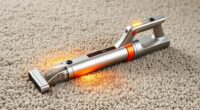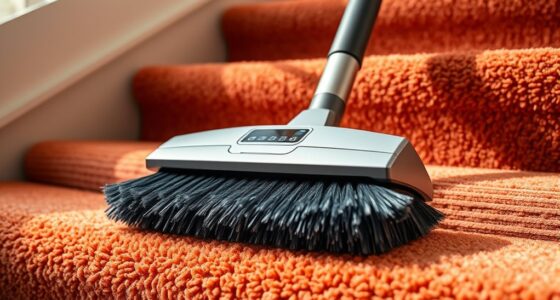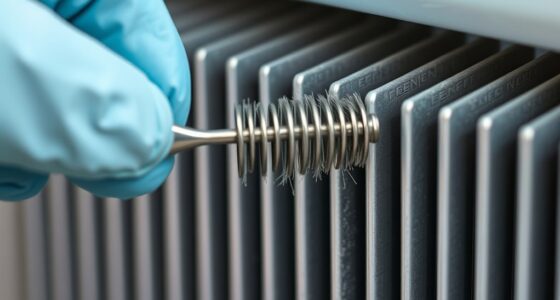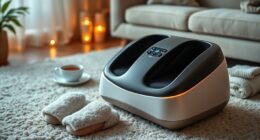To vacuum pet hair like a pro during shedding season, invest in a model with strong suction, adjustable height, and specialized attachments like motorized brushes and upholstery tools. Vacuum slowly and thoroughly, focusing on high-shedding areas, and use multiple passes to lift embedded hair. Regularly clean filters and brush rolls to maintain maximum efficiency. Using these tips and the right equipment will transform your cleaning routine—discover more expert techniques for a fur-free home.
Key Takeaways
- Use vacuums with strong suction, adjustable height, and specialized pet hair attachments like motorized brushes.
- Vacuum slowly, overlapping passes, focusing on high-shedding areas such as pet beds and furniture.
- Regularly clean filters, empty canisters, and remove hair from brushes to maintain optimal suction.
- Utilize upholstery tools and handheld attachments for tight spots and furniture surfaces.
- Increase vacuuming frequency during shedding season and vacuum against the grain of carpets for deeper hair removal.

Pet hair can quickly accumulate on your furniture and floors, making your home look messy and feeling less comfortable. During shedding season, it seems like no matter how often you vacuum, pet hair finds a way to cling to every surface. To keep your space tidy and inviting, mastering pet hair removal with your vacuum is essential. The key isn’t just running the vacuum over your floors; it’s about using it effectively and maintaining it properly to maximize cleaning power.
First, choose a vacuum designed for pet hair removal. Look for models with strong suction, adjustable height settings, and specialized attachments like motorized brushes or upholstery tools. These features are vital because they help lift pet hair from carpets, furniture, and tight corners. When you start vacuuming, don’t rush. Go slowly and overlap your passes to ensure you pick up every strand. Pay special attention to high-shedding areas like pet beds, sofa cushions, and entryways. For stubborn hair embedded deep in carpets, consider using a brush roll or be prepared to make multiple passes.
Vacuum maintenance is equally important. After every use, check the vacuum’s filters and empty the canister or replace the bag. Dirty filters and full canisters reduce suction, making pet hair removal less effective. Regularly cleaning or replacing filters guarantees your vacuum performs at its best. Additionally, inspect the brush roll for hair entanglement, as tangled hair can impede its rotation. Removing debris from the brush helps maintain maximum pick-up power. If your vacuum has a HEPA filter, change it as recommended to trap allergens and pet dander more efficiently. Proper maintenance not only prolongs the life of your vacuum but also guarantees perfect pet hair removal every time. Incorporating vacuum technology that is optimized for pet hair can significantly enhance your cleaning results.
To boost your cleaning efforts, use handheld attachments or upholstery tools for furniture and tight spaces. These tools can reach areas that the main vacuum might miss, ensuring thorough pet hair removal from all surfaces. When vacuuming, go against the grain of the carpet or rug fibers if possible, lifting trapped hair more effectively. Also, consider vacuuming frequently during shedding season—daily if needed—to prevent hair from accumulating and becoming harder to remove over time.
Frequently Asked Questions
Which Vacuum Attachments Work Best for Pet Hair Removal?
You’ll want to choose vacuum attachments like a motorized brush or upholstery tool for pet hair removal, as they’re most effective. Using the right vacuum bag types can help contain hair and prevent clogging. Don’t forget to sustain your filter regularly to keep suction strong and ensure pet hair doesn’t get blown back into the air. Combining these attachments with proper filter maintenance makes cleaning up pet hair much easier.
How Often Should I Vacuum During Shedding Season?
Think of vacuuming during shedding season as chasing a moving target—you need to stay consistent. You should vacuum at least 3-4 times a week to combat pet hair accumulation effectively. Regular vacuum maintenance ensures your device works at its best, making hair removal easier. The more often you vacuum, the less pet hair gets a chance to settle deep into your carpets and furniture, keeping your home cleaner and fresher.
Can I Use My Regular Vacuum on My Pet’S Bed?
You can use your regular vacuum on your pet’s bed, but be aware of pet hair myths that suggest all vacuums handle pet hair equally. Check your vacuum’s attachments and filter to guarantee effective cleaning. Regular vacuum maintenance is key—clean filters and brushes often. Using the right tools, like an upholstery brush, helps remove pet hair more efficiently and prolongs your vacuum’s lifespan, making cleaning easier and more effective.
Are There Specific Vacuum Brands Recommended for Pet Hair?
Imagine a vacuum powered to tackle pet hair with ease. When choosing a vacuum brand, look for recommendations that highlight strong suction, excellent filtration, and specialized pet hair vacuum features like brushes designed for fur. Brands like Dyson, Shark, and Bissell often top the list, offering tools that grip and lift pet hair effortlessly. These vacuums turn shedding chaos into clean spaces, making your cleaning routine smoother and more effective.
How Do I Prevent Pet Hair From Spreading During Vacuuming?
To prevent pet hair from spreading during vacuuming, focus on pet hair containment by using a vacuum with strong suction and a HEPA filter. Adopt effective vacuuming techniques, like slow, overlapping passes and vacuuming in multiple directions. Wear a fitted mask or use a damp cloth to catch loose hair. Keep pets off furniture during cleaning, and empty the vacuum immediately afterward to avoid re-contamination.
Conclusion
So, who knew that vacuuming pet hair like a pro during shedding season would be your secret weapon? Turns out, all that time fighting a losing battle was just practice for mastering the art. Ironically, the more you vacuum, the less hair seems to stick around—yet the shedding never quite ends. But hey, at least you’ll be a pro at making your home look fur-free, even if your furry friend’s shedding saga continues.









